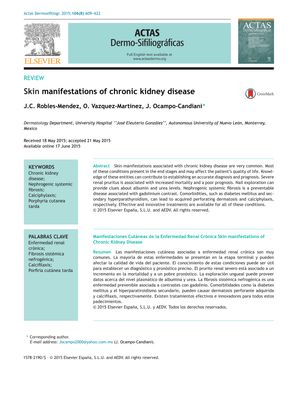Skin Manifestations of Chronic Kidney Disease
September 2015
in “
Actas Dermo-Sifiliográficas
”
renal pruritus calciphylaxis hemodialysis steroids keratolytics retinoids immunosuppressants parathyroidectomy kidney transplant cinacalcet wound management extracorporeal photopheresis imatinib mesylate UV-A 1 phototherapy bisphosphonates prednisone sodium thiosulfate hyperbaric oxygen therapy autologous skin grafts iloprost infusion pigmentary changes infections nail disorders hair disorders itching skin ulcers dialysis corticosteroids skin exfoliants vitamin A derivatives immune system suppressants gland removal surgery kidney surgery Sensipar wound care ECP Gleevec light therapy bone density drugs Deltasone thiosulfate oxygen therapy skin grafts Ventavis skin color changes nail problems hair problems

TLDR People with advanced chronic kidney disease often have skin problems, which can be treated with various medications and procedures to improve their quality of life.
The document reviews the various skin manifestations that can occur in patients with chronic kidney disease (CKD), particularly in the end stages, and the treatments available for these conditions. It notes that severe renal pruritus is common, affecting 50-90% of patients with end-stage CKD, and is associated with increased mortality. The review also discusses conditions such as calciphylaxis, which is characterized by painful skin nodules or plaques and can lead to ulcers with black eschar. Treatments for CKD-related skin conditions include improving hemodialysis quality, medications like steroids, keratolytics, retinoids, and immunosuppressants, and procedures such as parathyroidectomy and kidney transplant. For calciphylaxis, treatments include surgical parathyroidectomy, cinacalcet, and wound management. Other treatments mentioned for various skin conditions include extracorporeal photopheresis, imatinib mesylate, UV-A 1 phototherapy, bisphosphonates, prednisone, sodium thiosulfate, hyperbaric oxygen therapy, autologous skin grafts, and iloprost infusion. The document also covers other skin-related issues in CKD patients, such as pigmentary changes, infections, and nail and hair disorders, with specific treatments for each. Recognizing and treating these skin manifestations is emphasized as crucial for improving CKD patients' quality of life.




